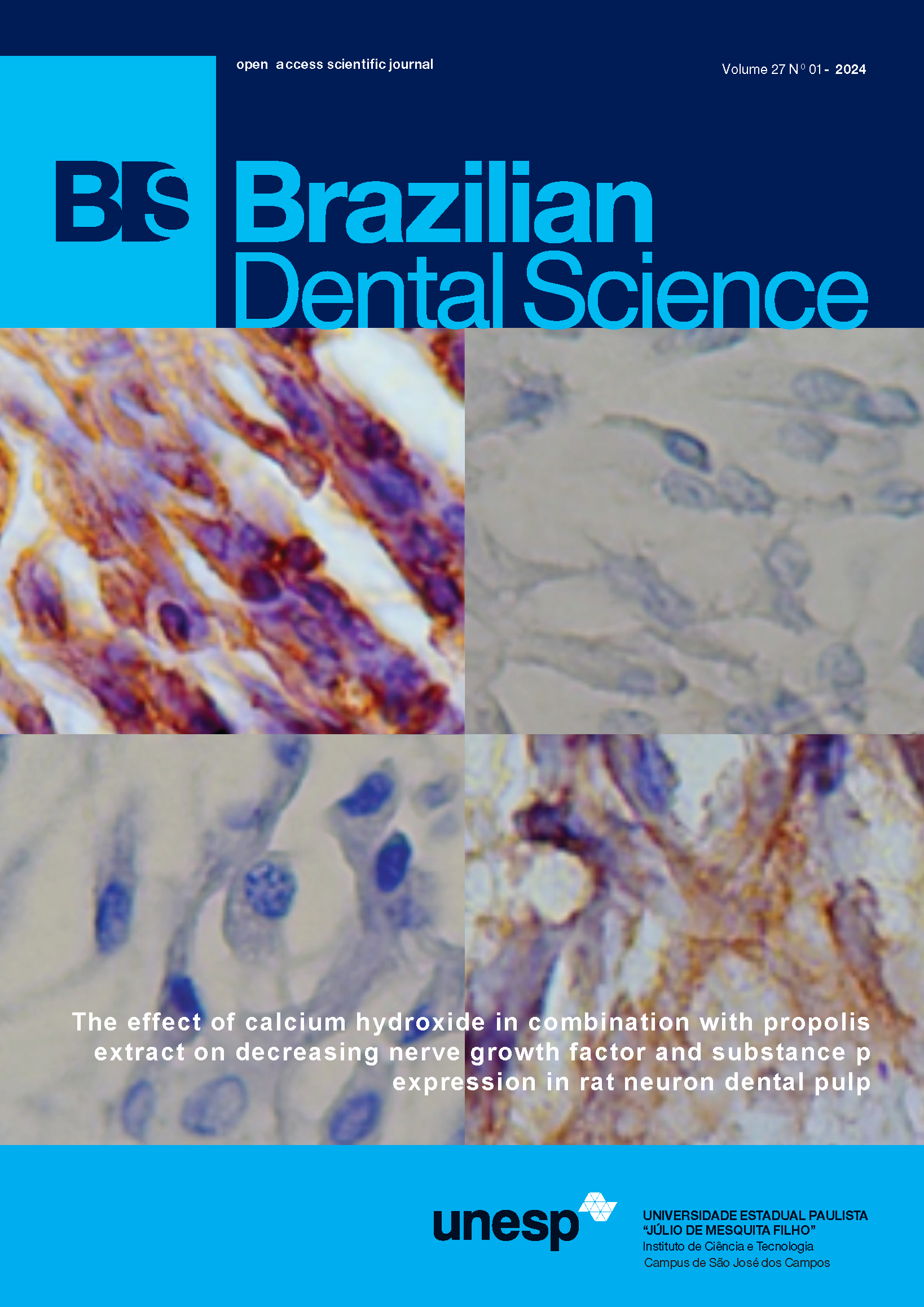Effect of glass-fiber post on the biomechanical behavior of teeth with direct veneers
DOI:
https://doi.org/10.14295/bds.2020.v23i3.1969Abstract
Objective: This study aimed to evaluate the biomechanical behaviour of endodontically treated teeth with direct veneer that received or not intra-radicular glass fiber post by finite elements analysis. Material and methods: Six models were designed, varying the presence or absence of glass fiber post and the thickness of direct veneer (0.5, 0.7 and 1 mm). Tridimensional models of maxillary central incisors were obtained with CAD software, Rhinoceros 4.0, and transferred to CAE software, ANSYS 17.2, which a 100N load was applied in a 45° on the lingual surface to simulate functional movements. Geometry contacts were bonded, and the structures were isotropic, linear, elastics, and homogeneous. After coherence and convergence analysis of mashes, the chosen fail criterion was the maximum principal stresses. Results: For cement, glass fiber post, the stress distribution was similar independently of glass fiber post presence or veneer thickness. Models with glass fiber post had better stress distribution and lower values of maximum stress for inner dentin and veneers. Veneers with 0.5 and 1 mm had higher stress concentration areas. Conclusions: It can be concluded that glass fiber post is favorable for restored teeth with direct veneers, and very thin or very thick preparations can damage the biomechanical behavior of restorations.
Keywords
Dental veneers; Finite element analysis; Nonvital tooth; Post and core technique.
References
Korkut B, Yanıkoğlu F, Günday M. Direct composite laminate veneers: three case reports. J Dent Res Dent Clin Dent Prospects. 2013;7(2):105‐111. doi:10.5681/joddd.2013.019
Pini NP, Aguiar FH, Lima DA, Lovadino JR, Terada RS, Pascotto RC. Advances in dental veneers: materials, applications, and techniques. Clin Cosmet Investig Dent. 2012;4:9‐16. doi:10.2147/CCIDEN.S7837
Gresnigt MM, Kalk W, Ozcan M. Randomized controlled split-mouth clinical trial of direct laminate veneers with two micro-hybrid resin composites. J Dent. 2012;40(9):766‐75. doi:10.1016/j.jdent.2012.05.010
Matson MR, Lewgoy HR, Barros Filho DA, Amore R, Anido-Anido A, Alonso RC, et al. Finite element analysis of stress distribution in intact and porcelain veneer restored teeth. Computer methods in biomechanics and biomedical engineering. 2012;15(8):795-800. doi: 10.1080/10255842.2011.561013.
Akoğlu B, Gemalmaz D. Fracture resistance of ceramic veneers with different preparation designs. J Prosthodont. 2011;20(5):380‐4. doi:10.1111/j.1532-849X.2011.00728.x
Layton DM, Clarke M, Walton TR. A systematic review and meta-analysis of the survival of feldspathic porcelain veneers over 5 and 10 years. Int J Prosthodont. 2012;25(6):590‐603.
Ausiello P, Franciosa P, Martorelli M, Watts DC. Mechanical behavior of post-restored upper canine teeth: a 3D FE analysis. Dent Mater. 2011;27(12):1285‐1294. doi:10.1016/j.dental.2011.09.009
Dal Piva AMO, Tribst JPM, Souza ROAE, Borges ALS. Influence of alveolar bone loss and cement layer thickness on the biomechanical behavior of endodontically treated maxillary incisors: a 3-dimensional finite element analysis. J Endod. 2017;43(5):791‐5. doi:10.1016/j.joen.2016.11.020
Al-Omiri MK, Mahmoud AA, Rayyan MR, Abu-Hammad O. Fracture resistance of teeth restored with post-retained restorations: an overview. J Endod. 2010;36(9):1439‐49. doi:10.1016/j.joen.2010.06.005
Dietschi D, Duc O, Krejci I, Sadan A. Biomechanical considerations for the restoration of endodontically treated teeth: a systematic review of the literature--Part 1. Composition and micro- and macrostructure alterations. Quintessence Int. 2007;38(9):733‐43.
Bergoli CD, Meira JB, Valandro LF, Bottino MA. Survival rate, load to fracture, and finite element analysis of incisors and canines restored with ceramic veneers having varied preparation design. Oper Dent. 2014;39(5):530‐40. doi:10.2341/13-179
Chieruzzi M, Pagano S, Cianetti S, Lombardo G, Kenny JM, Torre L. Effect of fibre posts, bone losses and fibre content on the biomechanical behaviour of endodontically treated teeth: 3D-finite element analysis. Mater Sci Eng C Mater Biol Appl. 2017;74:334‐46. doi:10.1016/j.msec.2016.12.022
Coelho-de-Souza FH, Goncalves DS, Sales MP, Erhardt MC, Correa MB, Opdam NJ, et al. Direct anterior composite veneers in vital and non-vital teeth: a retrospective clinical evaluation. J Dent. 2015;43(11):1330‐6. doi:10.1016/j.jdent.2015.08.011
Mosharraf R, Haerian A. Push-out bond strength of a fiber post system with two resin cements. Dent Res J (Isfahan). 2011;8(Suppl 1):S88‐S93.
. Rajambigai A, Kumar A, Sabarinathan, Raja R. Comparison of stress distribution in a maxillary central incisor restored with two prefabricated post systems with and without ferrule using finite element method. J Clin Diagn Res. 2016;10(9):ZC52‐ZC55. doi:10.7860/JCDR/2016/19443.8492
Skupien JA, Sarkis-Onofre R, Cenci MS, Moraes RR, Pereira-Cenci T. A systematic review of factors associated with the retention of glass fiber posts. Braz Oral Res. 2015;29:S1806-83242015000100401. doi:10.1590/1807-3107BOR-2015.vol29.0074
Soares CJ, Versluis A, Valdivia ADCM, Bicalho AA, Veríssimo C, Barreto BdCF, et al. Finite element analysis in dentistry-improving the quality of oral health care. Finite Element Analysis-From Biomedical Applications to Industrial Developments: InTech; 2012.
Trivedi S. Finite element analysis: A boon to dentistry. J Oral Biol Craniofac Res. 2014;4(3):200‐3. doi:10.1016/j.jobcr.2014.11.008
Versluis A, Tantbirojn D, Pintado MR, DeLong R, Douglas WH. Residual shrinkage stress distributions in molars after composite restoration. Dent Mater. 2004;20(6):554‐64. doi:10.1016/j.dental.2003.05.007
Friedman CE, Sandrik JL, Heuer MA, Rapp GW. Composition and physical properties of gutta-percha endodontic filling materials. J Endod. 1977;3(8):304‐8. doi:10.1016/S0099-2399(77)80035-6
Rosatto CM, Bicalho AA, Verissimo C, Braganca GF, Rodrigues MP, Tantbirojn D, et al. Mechanical properties, shrinkage stress, cuspal strain and fracture resistance of molars restored with bulk-fill composites and incremental filling technique. Journal of dentistry. 2015 Dec;43(12):1519-28. doi: 10.1016/j.jdent.2015.09.007.
Lassila LV, Tanner J, Le Bell AM, Narva K, Vallittu PK. Flexural properties of fiber reinforced root canal posts. Dent Mater. 2004;20(1):29‐36. doi:10.1016/s0109-5641(03)00065-4
Lopes CdCA, Rodrigues RB, Simamoto Júnior PC, Soares CJ, Novais VR. Degree of conversion and mechanical properties of resin cements cured through different all-ceramic systems. Braz Dent J. 2015;26(5):484-9.
Rundquist BD, Versluis A. How does canal taper affect root stresses? Int Endod J. 2006 Mar;39(3):226-37. doi: 10.1111/j.1365-2591.2006.01078.x.
Carter DR, Hayes WC. The compressive behavior of bone as a two-phase porous structure. J Bone Joint Surg Am. 1977;59(7):954‐62.
Conci RA, Tomazi FH, Noritomi PY, da Silva JV, Fritscher GG, Heitz C. Comparison of neck screw and conventional fixation techniques in mandibular condyle fractures using 3-dimensional finite element analysis. J Oral Maxillofac Surg. 2015;73(7):1321‐7. doi:10.1016/j.joms.2015.01.037
. Zarone F, Apicella D, Sorrentino R, Ferro V, Aversa R, Apicella A. Influence of tooth preparation design on the stress distribution in maxillary central incisors restored by means of alumina porcelain veneers: a 3D-finite element analysis. Dent Mater. 2005;21(12):1178‐88. doi:10.1016/j.dental.2005.02.014
Furuya Y, Huang SH, Takeda Y, Fok A, Hayashi M. Fracture strength and stress distributions of pulpless premolars restored with fiber posts. Dent Mater J. 2014;33(6):852‐8. doi:10.4012/dmj.2014-113
Influence of different post design and composition on stress distribution in maxillary central incisor: Finite element analysis. Indian J Dent Res. 2009;20(2):153‐8. doi:10.4103/0970-9290.52888
Baratieri LN, De Andrada MA, Arcari GM, Ritter AV. Influence of post placement in the fracture resistance of endodontically treated incisors veneered with direct composite. J Prosthet Dent. 2000;84(2):180‐4. doi:10.1067/mpr.2000.108415
Santos-Filho PC, Veríssimo C, Soares PV, Saltarelo RC, Soares CJ, Marcondes Martins LR. Influence of ferrule, post system, and length on biomechanical behavior of endodontically treated anterior teeth. J Endod. 2014;40(1):119‐23. doi:10.1016/j.joen.2013.09.034





